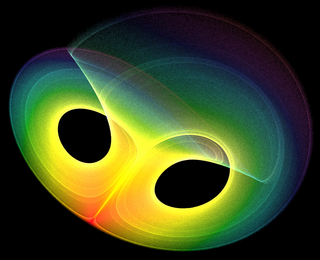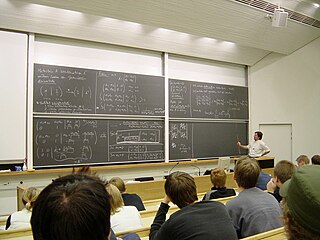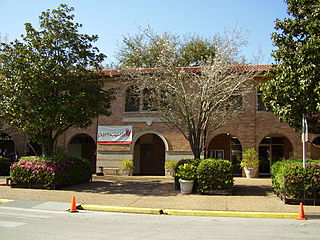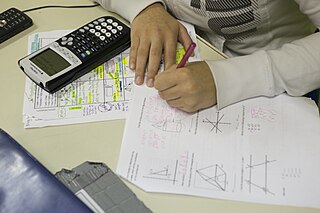
Analysis is the branch of mathematics dealing with continuous functions, limits, and related theories, such as differentiation, integration, measure, infinite sequences, series, and analytic functions.

In contemporary education, mathematics education—known in Europe as the didactics or pedagogy of mathematics—is the practice of teaching, learning, and carrying out scholarly research into the transfer of mathematical knowledge.
Lists of mathematics topics cover a variety of topics related to mathematics. Some of these lists link to hundreds of articles; some link only to a few. The template to the right includes links to alphabetical lists of all mathematical articles. This article brings together the same content organized in a manner better suited for browsing. Lists cover aspects of basic and advanced mathematics, methodology, mathematical statements, integrals, general concepts, mathematical objects, and reference tables. They also cover equations named after people, societies, mathematicians, journals, and meta-lists.

In mathematics education, precalculus is a course, or a set of courses, that includes algebra and trigonometry at a level which is designed to prepare students for the study of calculus, thus the name precalculus. Schools often distinguish between algebra and trigonometry as two separate parts of the coursework.
Further Mathematics is the title given to a number of advanced secondary mathematics courses. The term "Higher and Further Mathematics", and the term "Advanced Level Mathematics", may also refer to any of several advanced mathematics courses at many institutions.
Physics First is an educational program in the United States, that teaches a basic physics course in the ninth grade, rather than the biology course which is more standard in public schools. This course relies on the limited math skills that the students have from pre-algebra and algebra I. With these skills students study a broad subset of the introductory physics canon with an emphasis on topics which can be experienced kinesthetically or without deep mathematical reasoning. Furthermore, teaching physics first is better suited for English Language Learners, who would be overwhelmed by the substantial vocabulary requirements of Biology.

Saint Thomas' Episcopal School (STES) is a private, co-ed Episcopal institution serving Pre-kindergarten through 12th grade. It is located in the Meyerland area of Houston, Texas. The school has 553 students and 111 faculty members. It is accredited by the Southwestern Association of Episcopal Schools and is a member of the Houston Association of Independent Schools (HAIS) and the Texas Association of Private and Parochial Schools (TAPPS). Starting in 2020, STES will embark on a $29,000,000 construction project to restore and enhance the school campus. Construction is set to finish in the fall of 2021.
Mathematics education in New York in regard to both content and teaching method can vary depending on the type of school a person attends. Private school math education varies between schools whereas New York has statewide public school requirements where standardized tests are used to determine if the teaching method and educator are effective in transmitting content to the students. While an individual private school can choose the content and educational method to use, New York State mandates content and methods statewide. Some public schools have and continue to use established methods, such as Montessori for teaching such required content. New York State has used various foci of content and methods of teaching math including New Math (1960s), 'back to the basics' (1970s), Whole Math (1990s), Integrated Math, and Everyday Mathematics.
The Mathematics Subject Classification (MSC) is an alphanumerical classification scheme that has collaboratively been produced by staff of, and based on the coverage of, the two major mathematical reviewing databases, Mathematical Reviews and Zentralblatt MATH. The MSC is used by many mathematics journals, which ask authors of research papers and expository articles to list subject codes from the Mathematics Subject Classification in their papers. The current version is MSC2020.
Business mathematics are mathematics used by commercial enterprises to record and manage business operations. Commercial organizations use mathematics in accounting, inventory management, marketing, sales forecasting, and financial analysis.
Advanced Placement (AP) Calculus is a set of two distinct Advanced Placement calculus courses and exams offered by the American nonprofit organization College Board. AP Calculus AB covers basic introductions to limits, derivatives, and integrals. AP Calculus BC covers all AP Calculus AB topics plus additional topics.

Core-Plus Mathematics is a high school mathematics program consisting of a four-year series of print and digital student textbooks and supporting materials for teachers, developed by the Core-Plus Mathematics Project (CPMP) at Western Michigan University, with funding from the National Science Foundation. Development of the program started in 1992. The first edition, entitled Contemporary Mathematics in Context: A Unified Approach, was completed in 1995. The third edition, entitled Core-Plus Mathematics: Contemporary Mathematics in Context, was published by McGraw-Hill Education in 2015.
Integrated mathematics is the term used in the United States to describe the style of mathematics education which integrates many topics or strands of mathematics throughout each year of secondary school. Each math course in secondary school covers topics in algebra, geometry, trigonometry and functions. Nearly all countries throughout the world, except the United States, normally follow this type of integrated curriculum.

The Central Virginia Governor's School for Science and Technology (CVGS) is a regional school in Lynchburg, Virginia directed by Dr. Stephen Smith. Students are chosen from Lynchburg-area county and city schools. Schools participating in the Governor's School include those from Amherst County, Appomattox County, Bedford County, Campbell County, and the City of Lynchburg.
The Tennessee Governor's Academy for Mathematics and Science, commonly Tennessee Governor's Academy or TGA, was a residential high school located in Knoxville, Tennessee on the campus of The Tennessee School for the Deaf (TSD). It was founded in 2007 by Governor Phil Bredesen as part of an effort to provide challenges for students across the academic spectrum. Its inaugural class consisted of 24 high school juniors from throughout the state. The academy was closed on May 31, 2011, due to lack of state funding.
Math 55 is a two-semester long freshman undergraduate mathematics course at Harvard University founded by Lynn Loomis and Shlomo Sternberg. The official titles of the course are Studies in Algebra and Group Theory and Studies in Real and Complex Analysis. Previously, the official title was Honors Advanced Calculus and Linear Algebra.

Mathematics education in the United States varies considerably from one state to the next, and even within a single state. However, with the adoption of the Common Core Standards in most states and the District of Columbia beginning in 2010, mathematics content across the country has moved into closer agreement for each grade level. The SAT, a standardized university entrance exam, has been reformed to better reflect the contents of the Common Core. However, many students take alternatives to the traditional pathways, including accelerated tracks. As of 2023, twenty-seven states require students to pass three math courses before graduation from high school, while seventeen states and the District of Columbia require four. A typical sequence of secondary-school courses in mathematics reads: Pre-Algebra, Algebra I, Geometry, Algebra II, Pre-calculus, and Calculus or Statistics. However, some students enroll in integrated programs while many complete high school without passing Calculus or Statistics. At the other end, counselors at competitive public or private high schools usually encourage talented and ambitious students to take Calculus regardless of future plans in order to increase their chances of getting admitted to a prestigious university and their parents enroll them in enrichment programs in mathematics.
Additional Mathematics is a qualification in mathematics, commonly taken by students in high-school. It features a range of problems set out in a different format and wider content to the standard Mathematics at the same level.
The Pelham Memorial High School is the only high school within the town of Pelham, New York, United States. It is part of the Pelham Union Free School District.
Mathematics is a broad subject that is commonly divided in many areas that may be defined by their objects of study, by the used methods, or by both. For example, analytic number theory is a subarea of number theory devoted to the use of methods of analysis for the study of natural numbers.






